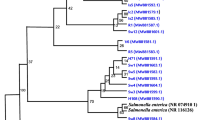Abstract
Purpose
Extraintestinal pathogenic E. coli (ExPEC) are important pathogens causing community-acquired infections in humans, including bloodstream infections (BSIs), and may also colonize and infect animals. Our aim was to investigate associations between incidence rates (IRs) of BSIs caused by ExPEC and number of dogs and cats in communities in Calgary.
Methods
We used a well-characterized collection of blood isolates (n = 685) from Calgary, Alberta, Canada (2016). We used a combination of a seven-single-nucleotide-polymorphism quantitative PCR to type ExPEC into sequence types (STs). Calgary census data were used to estimate IRs per city community, as well as to investigate associations between number of companion animals per community, as obtained from licensing data, and IR of BSIs caused by each dominant ST.
Results
From the 685 isolates available, ExPEC ST131 was most prevalent (21.3% of included isolates), followed by ST73 (13.7%), ST69 (8.2%), ST95 (6.7%), and ST1193 (5.3%), respectively. Incidence of BSIs caused by ExPECs among Calgary residents was 48.8 cases per 100,000 resident-years, whereas communities had on average of 1.7 companion animals per 10 residents. No association between the number of dogs and IR of BSIs caused by ExPECs was detected for any ST. Conversely, the incidence rate of BSIs caused by ST73 was 3.6 times higher (95%CI 1.3–9.99) for every increase of 1 cat per 10 habitants in communities.
Conclusions
Number of cats per habitant was positively associated with the incidence of BSIs caused by ExPEC ST73.



Similar content being viewed by others
References
Pitout JD. Extraintestinal pathogenic Escherichia coli: a combination of virulence with antibiotic resistance. Front Microbiol. 2012;3:9. https://doi.org/10.3389/fmicb.2012.00009.
Manges AR, Geum HM, Guo A, Edens TJ, Fibke CD, Pitout JDD. Global extraintestinal pathogenic Escherichia coli (ExPEC) lineages. Clin Microbiol Rev. 2019. https://doi.org/10.1128/CMR.00135-18.
Johnson JR, Davis G, Clabots C, Johnston BD, Porter S, DebRoy C, et al. Household clustering of Escherichia coli sequence type 131 clinical and fecal isolates according to whole genome sequence analysis. Open Forum Infect Dis. 2016;3:129. https://doi.org/10.1093/ofid/ofw129.
Timofte D, Maciuca IE, Kemmett K, Wattret A, Williams NJ. Detection of the human-pandemic Escherichia coli B2–O25b-ST131 in UK dogs. Vet Rec. 2014;174:352. https://doi.org/10.1136/vr.101893.
Belanger L, Garenaux A, Harel J, Boulianne M, Nadeau E, Dozois CM. Escherichia coli from animal reservoirs as a potential source of human extraintestinal pathogenic E. coli. FEMS Immunol Med Microbiol. 2011;62:1–10. https://doi.org/10.1111/j.1574-695X.2011.00797.x.
Kidsley AK, White RT, Beatson SA, Saputra S, Schembri MA, Gordon D, et al. Companion animals are spillover hosts of the multidrug-resistant human extraintestinal Escherichia coli pandemic clones ST131 and ST1193. Front Microbiol. 2020;11:1968. https://doi.org/10.3389/fmicb.2020.01968.
Holland MS, Nobrega D, Peirano G, Naugler C, Church DL, Pitout JDD. Molecular epidemiology of Escherichia coli causing bloodstream infections in a centralized Canadian region: a population-based surveillance study. Clin Microbiol Infect. 2020. https://doi.org/10.1016/j.cmi.2020.02.019.
Nobrega D, Peirano G, Lynch T, Finn TJ, Devinney R, Pitout JDD. Spatial distribution of Escherichia coli ST131 C subclades in a centralized Canadian urban region. J Antimicrob Chemother. 2021;76:1135–9. https://doi.org/10.1093/jac/dkab020.
Kidsley AK, O’Dea M, Ebrahimie E, Mohammadi-Dehcheshmeh M, Saputra S, Jordan D, et al. Genomic analysis of fluoroquinolone-susceptible phylogenetic group B2 extraintestinal pathogenic Escherichia coli causing infections in cats. Vet Microbiol. 2020;245:108685. https://doi.org/10.1016/j.vetmic.2020.108685.
Friedman ND, Kaye KS, Stout JE, McGarry SA, Trivette SL, Briggs JP, et al. Health care–associated bloodstream infections in adults: a reason to change the accepted definition of community-acquired infections. Ann Intern Med. 2002;137:791–7. https://doi.org/10.7326/0003-4819-137-10-200211190-00007.
The City of Calgary. Census by Community 2016. 2016. https://data.calgary.ca/Demographics/Census-by-Community-2016/hfwb-eab8. Accessed 27 Jan 2022.
Rue H, Martino S, Chopin N. Approximate Bayesian inference for latent Gaussian models by using integrated nested Laplace approximations. J R Stat. 2009;71:319–92. https://doi.org/10.1111/j.1467-9868.2008.00700.x.
Melendez D, Roberts MC, Greninger AL, Weissman S, No D, Rabinowitz P, et al. Whole-genome analysis of extraintestinal pathogenic Escherichia coli (ExPEC) MDR ST73 and ST127 isolated from endangered southern resident killer whales (Orcinus orca). J Antimicrob Chemother. 2019;74:2176–80. https://doi.org/10.1093/jac/dkz159.
Acknowledgements
We thank M. S. Holland for obtaining the clinical epidemiological data.
Funding
This work was supported by a research grant from the Joint Programming Initiative on Antimicrobial Resistance /Canadian Institute Health Research (#10016015).
Author information
Authors and Affiliations
Corresponding author
Ethics declarations
Conflict of interest
The authors declare that they have no conflict of interest.
Compliance with ethical standards
All procedures performed involving human participants were in accordance with the ethical standards of the institutional and national research committees.
Ethical approval
Ethics approval for this study was obtained through the University of Calgary Conjoint Health Research Ethics Board (REB16-2457).
Consent to participate
Not applicable.
Consent to publish
Not applicable.
Rights and permissions
About this article
Cite this article
Nobrega, D., Peirano, G. & Pitout, J.D.D. Escherichia coli sequence type 73 bloodstream infections in a centralized Canadian region and their association with companion animals: an ecological study. Infection 50, 1579–1585 (2022). https://doi.org/10.1007/s15010-022-01856-1
Received:
Accepted:
Published:
Issue Date:
DOI: https://doi.org/10.1007/s15010-022-01856-1




